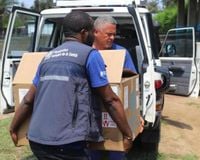In the heart of central Africa, a new Ebola outbreak is testing the resolve and resources of the Democratic Republic of the Congo (DRC) and the global health community. Announced on September 4, 2025, by the DRC’s Ministry of Public Health, Hygiene and Prevention, the outbreak has centered on the Bulape and Mweka health zones in Kasai Province. As of September 18, health authorities and international partners are racing to contain a virus known for its high fatality rate and devastating impact on communities.
According to the World Health Organization (WHO), there have been 48 confirmed and probable Ebola cases in the region, with 31 deaths reported—an alarming case fatality rate that underscores the gravity of the situation. The outbreak marks the first Ebola resurgence in the DRC in three years, and the numbers have climbed rapidly, nearly doubling the death toll since the previous week, as reported by the Associated Press.
The origins of this outbreak trace back to a 34-year-old pregnant woman who was admitted to a local hospital on August 20 with severe symptoms, including high fever and hemorrhaging. She died just five days later from multiple organ failure. Two healthcare workers who cared for her also succumbed to the disease, according to the Centers for Disease Control and Prevention (CDC). Laboratory testing at the National Institute of Biomedical Research (INRB) confirmed Ebola virus (species Orthoebolavirus zairense) as the culprit, and genomic sequencing suggests this is a new introduction from an unknown animal source, not a continuation of previous outbreaks.
The WHO has been quick to mobilize its resources. Dr. Tedros Adhanom Ghebreyesus, WHO Director-General, told reporters in Geneva that the organization and its partners have delivered more than 14 tons of essential medical equipment and supplies to the affected areas, and deployed 48 experts to support the Congolese response. “We’ve helped to set up an Ebola treatment centre with 18 beds, with 16 patients currently being treated,” Dr. Tedros said. On September 16, the first two patients to recover were discharged—a glimmer of hope amid the crisis.
Despite these efforts, the outbreak has not been easy to contain. The Africa Centers for Disease Control and Prevention noted last week that the disease, once limited to two districts, has now spread to four. More than 900 contacts have been identified and are under close monitoring, a number that illustrates both the scale of the response and the challenge of tracing potential new cases in a region with limited infrastructure.
Vaccination campaigns began on September 14 in the affected areas, targeting healthcare workers and known contacts. Dr. Patrick Otim, an official at WHO Africa’s program, reported that over 500 health workers and contacts have already received vaccinations, an essential step in curbing further transmission. However, the rollout has faced significant obstacles. “The vaccination has not been implemented as fast as we would have desired it to because of accessibility challenges which have caused delays in transporting the vaccines,” explained Sheillah Nsasiirwe, Health Emergency Officer for Immunization at WHO Africa. The lack of proper storage infrastructure in Bulape has meant vaccines are being transported in small batches, slowing the campaign’s progress. Additional vaccine doses, approved by the International Coordinating Group on Vaccine Provision, are scheduled to arrive between September 19 and 21, offering a much-needed boost to the effort.
Treatment for those already infected has also advanced. The WHO has deployed courses of the monoclonal antibody therapy Mab114 to treatment centers in Bulape, and so far, 14 patients have received the drug. The hope is that early intervention with proven therapies, combined with robust supportive care, can improve survival rates, which have varied widely in past outbreaks. The CDC notes that previous Ebola outbreaks in the DRC have had case fatality rates as high as 80 to 90%, though intensive care and fluid replacement can reduce fatalities.
Globally, the response has been swift but measured. The CDC issued a Health Alert Network advisory on September 18, emphasizing that the risk of spread to the United States remains low. There are no direct flights between the DRC and the U.S., and no suspected, probable, or confirmed Ebola cases related to this outbreak have been reported outside the DRC. Nevertheless, the CDC has deployed five experts to support local efforts and is advising travelers to the affected zones to avoid contact with ill people and to monitor themselves for symptoms for 21 days after leaving the area.
The CDC’s recommendations for U.S. public health departments and clinicians are clear: vigilance is key. Healthcare providers are urged to systematically assess patients with compatible symptoms and recent travel history, to consider Ebola in their differential diagnoses, and to isolate and manage any suspected cases according to strict biosafety protocols. Laboratories are reminded to handle all specimens with extreme caution, and public health officials are coordinating with the CDC for testing and patient management.
For the people of Kasai Province, this is not their first encounter with Ebola. The region experienced outbreaks in 2007 and 2008, with 264 cases and 187 deaths in the former, and 32 cases with 15 deaths in the latter. The current outbreak is the 16th in the DRC since the virus’s discovery in 1976 in the country’s dense tropical forests—forests that continue to serve as a natural reservoir for the virus, which is harbored mainly in fruit bats and can spill over to humans via contact with infected wildlife.
The Ebola virus is notorious for its rapid progression and severe symptoms, ranging from fever and body aches to diarrhea, vomiting, and unexplained bleeding. It spreads through direct contact with the bodily fluids of infected individuals or animals, or contaminated objects. Airborne transmission, however, does not occur. Survivors can sometimes harbor the virus for years, posing a risk of re-emergence.
As the outbreak unfolds, health officials remain cautiously optimistic. The deployment of vaccines and new therapies, combined with international support, offers tools that were not available during past crises. Yet, the challenges of geography, infrastructure, and public trust persist. The world is watching closely, hoping that the lessons of previous outbreaks and the swift action of global health agencies will keep this crisis from spiraling further.
The coming days will be critical for Kasai and the DRC as a whole. With more vaccines on the way and a robust network of contact tracing and treatment, authorities are racing against time to halt Ebola’s deadly advance. For now, the world holds its breath, waiting to see if science, solidarity, and determination can once again turn the tide against one of humanity’s most fearsome diseases.


